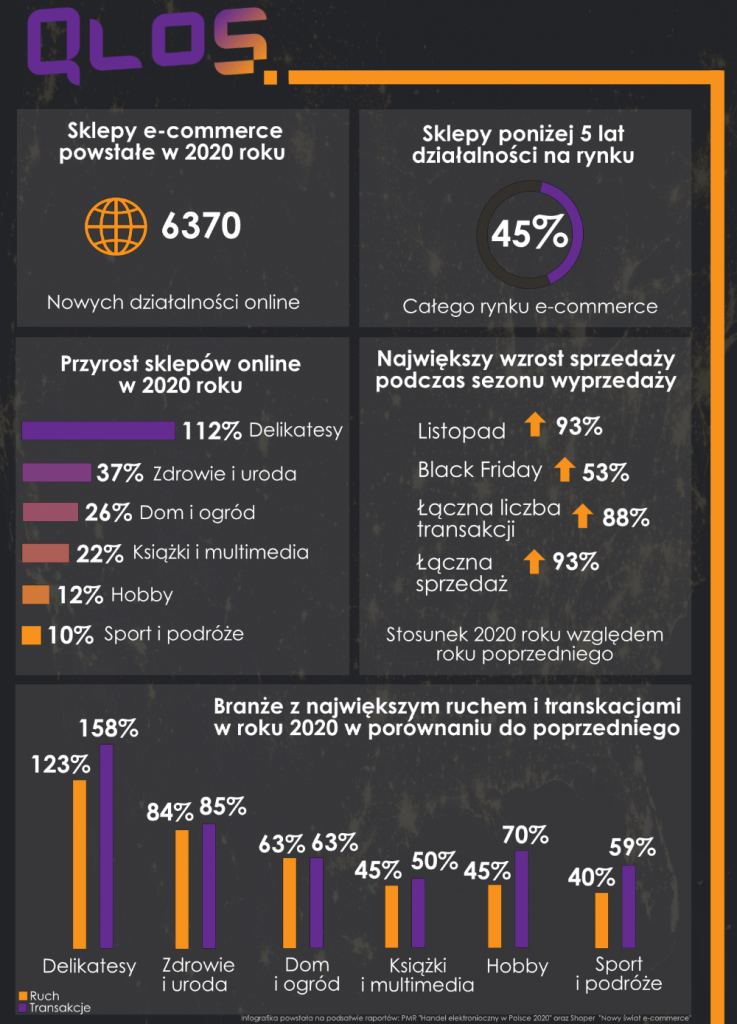
Information in the PMR report says that the value of the e-Commerce market in 2020 was 88.7 billion PLN. Senuto, on the other hand, reports that in Poland alone, at least 6,370 new online stores were created during this period. According to forecasts, in the baseline scenario, the value of the market will grow regularly in the coming years until it reaches a growth rate of 89% in 2026. Despite the general stalling of the economy due to the coronavirus epidemic, the e-Commerce industry is booming at its best.
Consumers during the pandemic, for the sake of their safety, are shifting their shopping habits to the web, where the cross-section, the number of products and services are constantly growing. The change in buying trends can be seen both in Poland and abroad, but we will focus on the domestic market. For example, comparing the availability of groceries online, in the period before and during the pandemic, shows a much greater range of choices.
Unfortunately, not all online businesses were able to cope with the multiplied site traffic. In some cases, we can see that even now companies have a huge problem with this. However, site overloads are not just caused by a sudden change related to the epidemic, frequent crashes mean much deeper problems, and COVID-19 has only highlighted this. Website overload can be directly related to inadequately tuned or prepared servers. It is worth mentioning that a site crash can also occur during a well-organized marketing or advertising campaign or holidays such as Black Friday, CyberMonday or Christmas.
When creating a business on the Internet, first of all, it is important to be aware of what elements are the basis of the business. The epicenter of any online business is the flexible and scalable environment in which the infrastructure is created. Without it, any development attempt may fail.
To confirm the above words, it is worth looking at the changes in the e-Commerce market that have taken place recently. According to the Shoper report in Poland, the biggest changes are being felt in the food industry. The number of orders of products from the “delicatessen” category increased by 158% compared to the previous year’s period. Demand also increased for drugstore products (59%), medicines (59%), books and multimedia (70%). Most of them are necessities. Interestingly, it was not only the core product categories that saw increased sales during the period. Growth can also be seen in the areas of “home and garden,” “sports and travel,” and “hobbies.” Thus, one might be tempted to conclude that due to the pandemic and increased leisure time, consumers increasingly relied on products that made staying at home more enjoyable.
An interesting benchmark is the comparison of sales from the sales period (Black Friday and the pre-Christmas period) 2019 versus 2020. According to the Shoper report, the volume of traffic in online stores in Poland has increased significantly, but so have the transactions themselves. It can be noted that users spent 93% more on Black Friday than in the previous year, and 53% more in November. The final results represented an 88% increase in the number of transactions, and the value of sales higher than the previous year by as much as 93%. Another hot selling period is behind us, so the current comparison will be updated soon. From my point of view, 2021 is a remarkable revolution in the market, which will significantly raise the mentioned indicators.

As you can see, the number of orders, as well as the value of the basket in each industry, is increasing month by month. It is inevitable that the situation in the coming time will further strengthen the importance of e-commerce, due to the dynamic epidemiological situation. The human factor determines the transformation of the online market to the greatest extent. All studies indicate that in the coming years the position of online businesses will strengthen, thus degrading stationary stores. Therefore, adapting the current environment to current changes is a priority for the e-Commerce industry.
Under the famous word “overload” is nothing more than the load on the servers by an application leading to saturation of resources. When we purchase a hosting service, we buy a limited amount of resources, known to us in advance. Their saturation causes the server to be unable to properly handle the application. Customers’ shopping experience suffers severely when the site runs slowly or when they see an error message not allowing them to indulge in their shopping pleasure. The consequence will be a definite reluctance on the part of the customer to continue shopping, which will translate into an overall shopping experience.
Allowing such a situation introduces a lot of panic among the store owners, but also the customers themselves, if the goods sold are first necessities. Changing hosting with higher parameters may be a good option, but for a short while. It’s a natural choice, for a “quick, right now” solution, but as research shows, the online shopping trend in Poland will continue to grow in the coming years. Through the dynamic change of the current situation, many e-stores are targeting a competitive advantage. A constant need for such stores is additional resources to serve the growing number of customers. The e-Commerce industry needs a solution that can be adapted to each type of business, as well as to the particular moment the company is currently in. Scalability, but also flexibility, are two features that should be a priority for any platform on which an online store operates.
A solution that does not require constant change and will be ideal in this area is cloud computing. Its main tenets are flexible matching of resources to actual needs. In addition, having the store in the cloud, we pay only for the resources used. We do not incur fees for unused resources, as with traditional server infrastructure. During periods of high traffic, cloud resources increase without affecting the Customer Experience. It is also important to remember that less traffic equals a decrease in the parameters of virtual servers, without putting a strain on the budget. In addition, other servers lack functionality in the form of scalability, which not only takes care of the flexibility of the space to meet actual needs, but also the budget of the customer using the cloud. No matter what kind of business you run, the cloud will fit you and your business needs.
Investing money in technology is always a return investment. Especially if you take advantage of the wide range of cloud computing capabilities. The change can be seen immediately, primarily in the number of customers served. By optimizing every element of the site, there are no problems in welcoming a thousand times more users at once. This definitely affects the size of the company’s revenue. The pluses of switching infrastructure to the cloud are also seen in the costs associated with operating IT services, due to the scalability of the model. In the long term, you can see the money saved. That’s thanks to the cloud’s flexible adaptation to resources, thanks mainly to a pay-as-you-go model. In addition, by moving the site to the cloud, we can take advantage of additional services, among others. in the form of building customer databases, and give them to analysis that takes place in real time. This increases comfort in marketing activities, but also sales opportunities, by properly matching products or services to customer preferences.
Changing a service from classic hosting to cloud hosting involves expanding your knowledge of the new environment and gaining the skills to manage it. Through rapid economic changes, related to the pandemic, but also market development, learning more things is probably not feasible. Against the backdrop of the new reality that we have to adapt to, the list of responsibilities involved in running a store is getting longer and longer. That’s why it’s a good idea to delegate the migration of your existing environment or the creation of a new one to specialists who will make the changes without interrupting your site.
However, starting operations in the cloud is not the same as operating properly. For this to happen, the transferred services must be managed by people with the right knowledge and experience. One such functionality is server administration. This is a major part of the smooth functioning of the entire platform from the inside. Authorized persons are responsible for the proper maintenance of servers, optimize each operation so that costs are as low as possible with the optimal configuration. In addition, they perform infrastructure audit, which is responsible for the performance and security of the entire online store. It is worthwhile to take an interest in the services of trained administrators if you do not have an employee directly trained in this field. Cloud providers have partners that very often offer additional IT solutions in the form of virtual server management in addition to migrating services to the cloud.
At this very moment, the e-commerce industry is experiencing a significant revolution that could leave its mark for a very long time. It is worthwhile to check the performance of your e-store today and consider whether its technological foundation needs to be changed. The quicker the response to the problem, the smaller the losses and the greater the benefits.